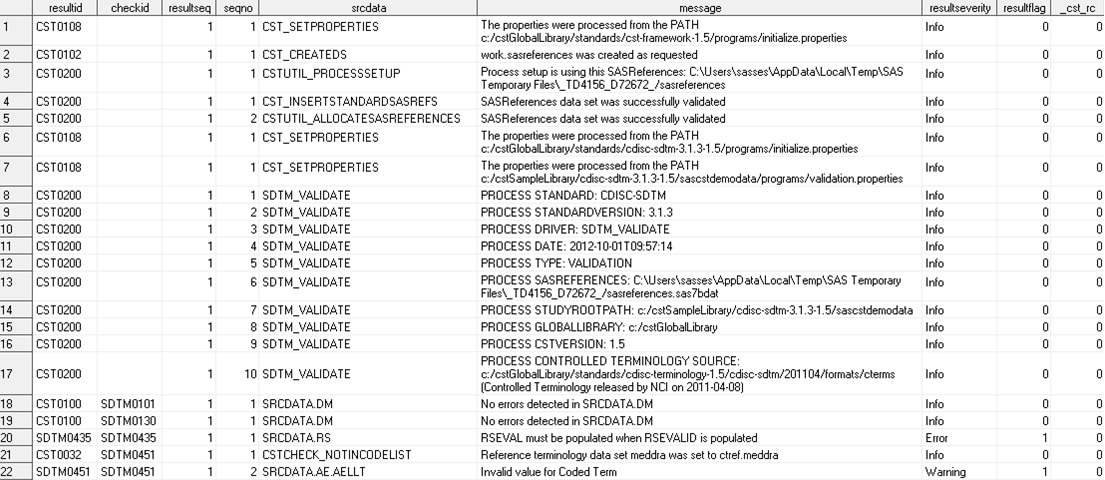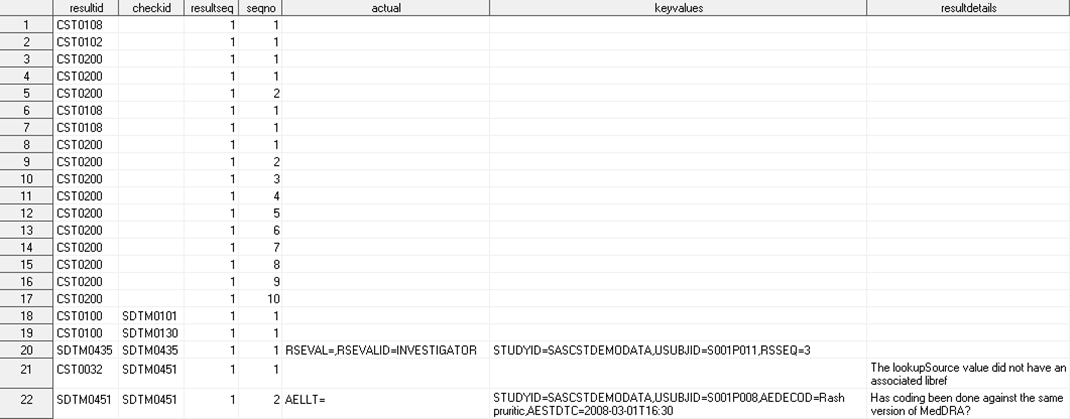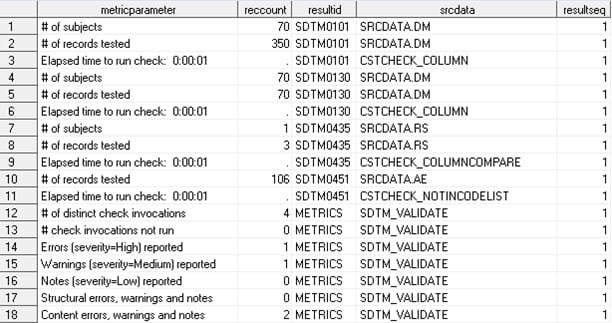Running a Validation Process
Sample CDISC SDTM 3.1.3 Driver Program: validate_data.sas
Overview
Each SAS Clinical Standards
Toolkit process uses a SAS driver module to set up the program execution
flow. The following steps show the execution flow in a typical SAS
driver module to perform the SAS Clinical Standards Toolkit validation.
For example, the CDISC SDTM 3.1.3 validation driver module is in:
sample study library directory/cdisc-sdtm-3.1.3–1.5.
Step 1: Define macro variables required by the validation process.
%let _cstStandard=CDISC-SDTM; %let _cstStandardVersion=3.1.3; %let _cstVersion=; %let _cstCTPath=; %let _cstCTMemname=; %let _cstCTDescription=;
These macro variables
are used as substitution parameters later in the driver module to
reduce the number of code changes required.
Initialize the minimum
set of global macro variables used to run any SAS Clinical Standards
Toolkit process. This includes the names of work data sets, default
locations of files, and metadata used to populate the process Results
data set.
Each registered standard
should have its own initialize.properties. For each standard that
is included in a specific process, the %cst_setstandardproperties
macro can be called at this point. Alternatively, type=properties
records can be added to the SASReferences data set, and the properties
are processed when the %cstutil_allocatesasreferences macro is called.
This latter approach is followed in the SDTM validate_data.sas driver
module.
%cst_getRegisteredStandards(_cstOutputDS=work._cstStandards);
data _null_;
set work._cstStandards (where=(standard="CST-FRAMEWORK"));
call symputx('_cstVersion',strip(productrevision));
run;
Get the list of registered
standards to determine the version of the SAS Clinical Standards Toolkit.
* Set Controlled Terminology version for this process *;
%cst_getstandardsubtypes(_cstStandard=CDISC-TERMINOLOGY,_cstOutputDS=work._cstStdSubTypes);
data _null_;
set work._cstStdSubTypes (where=(standardversion="&_cstStandard" and isstandarddefault='Y'));
* User can override CT version of interest by specifying a different where clause: *;
* Example: (where=(standardversion="&_cstStandard" and standardsubtypeversion='201104')) *;
call symputx('_cstCTPath',path);
call symputx('_cstCTMemname',memname);
call symputx('_cstCTDescription',description);
run;
proc datasets lib=work nolist;
delete _cstStandards _cstStdSubTypes;
quit;
Choose the default controlled
terminology that is associated with the _cstStandard and _cstStandardVersion.
Cleanup work files.
*********************************************************************************************;
* The following data step sets (at a minimum) the studyrootpath and studyoutputpath. These *;
* are used to make the driver programs portable across platforms and allow the code to be *;
* run with minimal modification. These macro variables by default point to locations within *;
* the cstSampleLibrary, set during install but modifiable thereafter. The cstSampleLibrary *;
* is assumed to allow write operations by this driver module. *;
*********************************************************************************************;
%cstutil_setcstsroot;
data _null_;
call symput('studyRootPath',cats("&_cstSRoot",
"/cdisc-sdtm-3.1.3-&_cstVersion/sascstdemodata"));
call symput('studyOutputPath',cats("&_cstSRoot",
"/cdisc-sdtm-3.1.3-&_cstVersion/sascstdemodata"));
run;Step 2: Build and populate the SASReferences data set
%let _cstSetupSrc=SASREFERENCES;
*****************************************************************************************;
* One strategy to defining the required library and file metadata for a CST process *;
* is to optionally build SASReferences in the WORK library. An example of how to do *;
* this follows. *;
* *;
* The call to cstutil_processsetup below tells CST how SASReferences will be provided *;
* and referenced. If SASReferences is built in work, the call to cstutil_processsetup *;
* may, assuming all defaults, be as simple as %cstutil_processsetup() *;
*****************************************************************************************;
*****************************************************************************************;
* Build the SASReferences data set *;
* column order: standard, standardversion, type, subtype, sasref, reftype, iotype, *;
* filetype, allowoverwrite, relpathprefix, path, order, memname, comment *;
* note that &_cstGRoot points to the Global Library root directory *;
* path and memname are not required for Global Library references - defaults will be used*;
******************************************************************************************;
%cst_createdsfromtemplate(_cstStandard=CST-FRAMEWORK, _cstType=control,_cstSubType=reference,
_cstOutputDS=work.sasreferences);
proc sql;
insert into work.sasreferences
values ("CST-FRAMEWORK" "1.2" "messages" "" "messages" "libref" "input" "dataset"
"N" "" "" 1 "" "")
values ("&_cstStandard" "&_cstStandardVersion" "control" "validation" "cntl_v" "libref"
"input" "dataset" "N" "" "&studyRootPath/control" . "validation_control.sas7bdat" "")
[etc.]
;
quit;
The cst_createdsfromtemplate
macro initializes the SASReferences data set that is required for
SDTM validation. The SASReferences data set defines the location and
name of each input metadata source, input data source, and output
file that is created by the validation process, including the Validation
Control data set. The Validation Control data set contains the set
of checks to include in the validation process. The sample validate_data.sas
driver program sets the path of the Validation Control data set to
&studyRootPath/control and
sets the name to validation_control.sas7bdat. Based on the code executed
in step 1, this is the path:
For an explanation
of the purpose and content of each SASReferences file, see SASReferences File. For a fully
initialized SASReferences data set for SDTM validation, see Sample SASReferences File for CDISC SDTM Validation.
Step 3: Call the %cstutil_processsetup macro.
The %cstutil_processsetup
macro completes process setup. It ensures that all SAS librefs and
filerefs are allocated; all system options, macro autocall paths,
and format search paths are set; and that all global macro variables
that are required by the process have been appropriately initialized.
The %cstutil_processsetup
macro uses these parameters.
cstSASReferencesSource
This parameter determines
what initial source setup should be based on. Valid values are SASREFERENCES
(default) or RESULTS. If RESULTS is specified, then no other parameters
are required, and setup responsibility is passed to the cstutil_reportsetup
macro. The Results data set name must be passed to cstutil_reportsetup
as libref.memname.
The %cstutil_processsetup
macro call:
%cstutil_processsetup();in the validate_data.sas driver reflects the acceptance of the macro parameter defaults listed above.
The %cstutil_processsetup
macro parameter values tell the process where to find the SASReferences
data set.
*********************************************************************; * Set global macro variables for the location of the sasreferences *; * file (overrides default properties initialized above *; *********************************************************************; %let _cstSASRefsName=&_cstSASReferencesName; %let _cstSASRefsLoc=&_cstSASReferencesLocation;
The final setup step
for the %cstutil_processsetup macro is a call to the %cstutil_allocatesasreferences
utility macro. The SASReferences data set is now interpreted by the
SAS Clinical Standards Toolkit. These actions complete the process:
-
The %cst_insertstandardsasrefs macro is called to insert paths into any records that are missing path information. The information is captured from the StandardSASReferences data set for each standard. For more information about how this works, see Inserting Information from Registered Standards into a SASReferences File.
-
Multiple calls to the %cstutilvalidatesasreferences macro are made to perform internal validation on the SASReferences data set.The validation performed by the %cstutilvalidatesasreferences macro is described in theAssessing Structural Integrity and Content.
At this point, all libraries
should be allocated, all paths and global macros should be set, and
the global status macro variable _cst_rc should be set to 0. The process
is ready to proceed.
CAUTION:
The SASReferences
data set is key to the process, and any errors will cause the process
to fail.
This is a common process
failure point because of the importance of the SASReferences data
set. For tips on
debugging problems with the SASReferences data set, see Special Topic: Debugging a Validation Process and Assessing Structural Integrity and Content.
Step 4: Run validation tasks.
For tips on
debugging if unexpected errors occur, see Special Topic: Debugging a Validation Process.
Step 5: Clean up the session.
Parameter Details
This table summarizes
what the SAS Clinical Standards Toolkit attempts to do when each of
the %cstutil_cleanupcstsession macro parameters is enabled.
Validation Results and Metrics
For SAS Clinical Standards
Toolkit validation processes, the primary products of each validation
process are the Results data set and the Metrics data set. These data
sets itemize and summarize the findings of the validation process.
Example of a Validation Results Data Set (#1) summarizes a sample validation process. Here
are a few facts about the sample validation process:
-
It included SASReferences records to persist the results as results.validation_results and results.validation_metrics.
Here are some general
observations:
-
The seqno field is intended to be a record (message) counter in each specific check invocation. Generally, this value starts with 1 on the first record, and increments by 1 until the last record for each checkid and resultseq combination. One exception is with the Validation Control column reportAll=N. This signals the code to not write a record to the Results data set for each record in error. However, seqno continues to increment in this case, resulting in a gap in seqno values, with the last seqno approximating the total number of records in error.
A set of sample validation
reports is available to summarize the SAS Clinical Standards Toolkit
validation process results and metrics. For more
information, see Reporting.
Copyright © SAS Institute Inc. All rights reserved.


